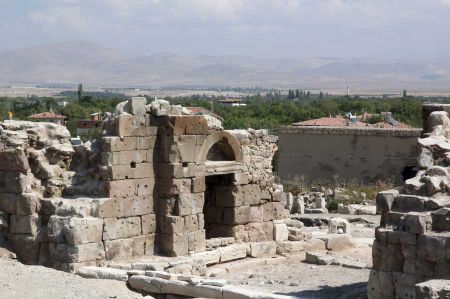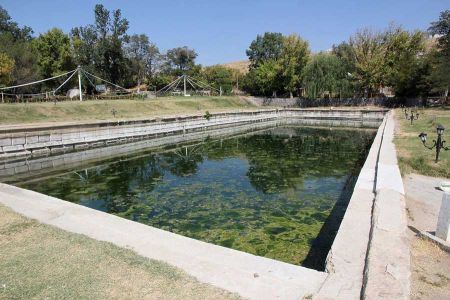Tyana – Ruins of a City near Nigde in Cappadocia
- Written by Portal Editor
Anyone who walks through Niğde Museum of Art History with open eyes will certainly come across the name Tyana several times, an ancient metropolis that has so far been little known from a tourist point of view.
Today's Kemerhisar emerged from Tyana south of Niğde, so another interesting destination on the way to visit Cappadocia.
Tyana probably corresponds to the Hittite Tuwanuwa that appears in the list of conquests of the early King Labarna I. In Assyrian sources it is called Tuhana. The main god of the city of Tuwanuwa was the weather god, whose name has unfortunately not been passed down. The wife of King Labarna I, however, was mentioned several times in the records, because she was alternately referred to as Sahassaras, Huwassanas and Tasimis. In Tyana there was also a centre of worship of the Hittite god Wurunkatti (Lord of the Land), who is also named with the Sumerian name Zababa. On the rock relief of İvriz from the late Hittite period (probably 8th century BC) a King Warpalawas of Tuwana is depicted with the god Tarhunzas.
Cappadocia initially became an independent kingdom
 In Hellenistic times, when Cappadocia was an independent kingdom, Tyana belonged to the two national centres alongside the royal seat of Mazaka in the north. The city was owned by Ariaramnes in the 260s BC. Was then torn from the Seleucids and later named after King Ariarathes V. Eusebes Philopator (ruled approx. 163-130 BC) as "Eusebeia at Tauros".
In Hellenistic times, when Cappadocia was an independent kingdom, Tyana belonged to the two national centres alongside the royal seat of Mazaka in the north. The city was owned by Ariaramnes in the 260s BC. Was then torn from the Seleucids and later named after King Ariarathes V. Eusebes Philopator (ruled approx. 163-130 BC) as "Eusebeia at Tauros".
When Cappadocia finally lost its independence in 17 AD, it was converted into the Roman province of Cappadocia, to which Tyana belonged too. Under the rulership of Emperor Caracalla, the city in Cappadocia became a prime Roman colony. It joined the uprising of Zenobia and was retaken by Aurelian, who, however, treated the city mildly. In 371 it became the capital of the Cappadocia Secunda with the rulership of Valens.
In 372, Emperor Valens divided the province of Cappadocia in two pieces and Tyana became the capital of Cappadocia Secunda. During late antiquity, the city was also known as Christoupolis, the "City of Christ".
Islamic expansion and conquest
 As a result of the Islamic expansion and the establishment of the new border between the Byzantine Empire and the Caliphate along the Taurus Mountains, Tyana became an important military base as it was on the road from Anatolia to Cilicia and Syria close to the Cilician Gate (approx. 30 km north). As a result, the city was often the target of Muslim raids. The city was first sacked by the Umayyads in 708 after a long siege and was abandoned for a while until it was rebuilt. It was then occupied by the Abbasid caliph Hārūn ar-Raschīd in 806. Harun turned the city into a military camp and built a mosque there, but had the city evacuated again after the Byzantine emperor Nikephorus I had paid for a kind of peace. The city was destroyed again by the Abbasids under Al-Abbas ibn al-Ma'mun in 831. Abbas had rebuilt the city three years later and turned into a military camp in preparation for al-Ma'mun's planned conquest of the Byzantine Empire, but after Ma'mun's sudden death in August 833 the plan was abandoned and the half-finished city was destroyed again.
As a result of the Islamic expansion and the establishment of the new border between the Byzantine Empire and the Caliphate along the Taurus Mountains, Tyana became an important military base as it was on the road from Anatolia to Cilicia and Syria close to the Cilician Gate (approx. 30 km north). As a result, the city was often the target of Muslim raids. The city was first sacked by the Umayyads in 708 after a long siege and was abandoned for a while until it was rebuilt. It was then occupied by the Abbasid caliph Hārūn ar-Raschīd in 806. Harun turned the city into a military camp and built a mosque there, but had the city evacuated again after the Byzantine emperor Nikephorus I had paid for a kind of peace. The city was destroyed again by the Abbasids under Al-Abbas ibn al-Ma'mun in 831. Abbas had rebuilt the city three years later and turned into a military camp in preparation for al-Ma'mun's planned conquest of the Byzantine Empire, but after Ma'mun's sudden death in August 833 the plan was abandoned and the half-finished city was destroyed again.
After that the city fell into disrepair as the Arab threat gradually subsided. The ruins of Tyana are located near what is now the Turkish city of Kemerhisar, where the remains of an ancient Roman aqueduct as well as cave tombs and burial grottoes can be found.
A large number of finds from Tyana and the nearby settlement mound Köşk Höyük can be viewed in the archaeological museum of Niğde, other finds in the museum of Ankara.
Church history relating to Tyana
 Bishop Eutherios of Tyana was the leader of the Nestorian faction at the Council of Ephesus in 431 and was therefore deposed, excommunicated and had to go into exile at short notice. When Firmus of Caesarea, who had participated in his excommunication, came to Tyana to consecrate his successor, both the citizens of the city and the Isaurian troops stationed here under Longras opposed him, and Firmus and the newly ordained bishop, who thereafter again returned to private life had to flee. Eutherios was exiled to Scythopolis (Palestine, Bet-Shean) and finally to Tire, where he died too.
Bishop Eutherios of Tyana was the leader of the Nestorian faction at the Council of Ephesus in 431 and was therefore deposed, excommunicated and had to go into exile at short notice. When Firmus of Caesarea, who had participated in his excommunication, came to Tyana to consecrate his successor, both the citizens of the city and the Isaurian troops stationed here under Longras opposed him, and Firmus and the newly ordained bishop, who thereafter again returned to private life had to flee. Eutherios was exiled to Scythopolis (Palestine, Bet-Shean) and finally to Tire, where he died too.
The name still continues as a titular Catholic archbishopric.
Coordinates: 37 ° 49 ′ 24 ″ N, 34 ° 34 ′ 14 ″ E
Please read as well:
Nigde - the Hettite town of Nahita
The Stöckl - historical market place in Cheb-Eger
